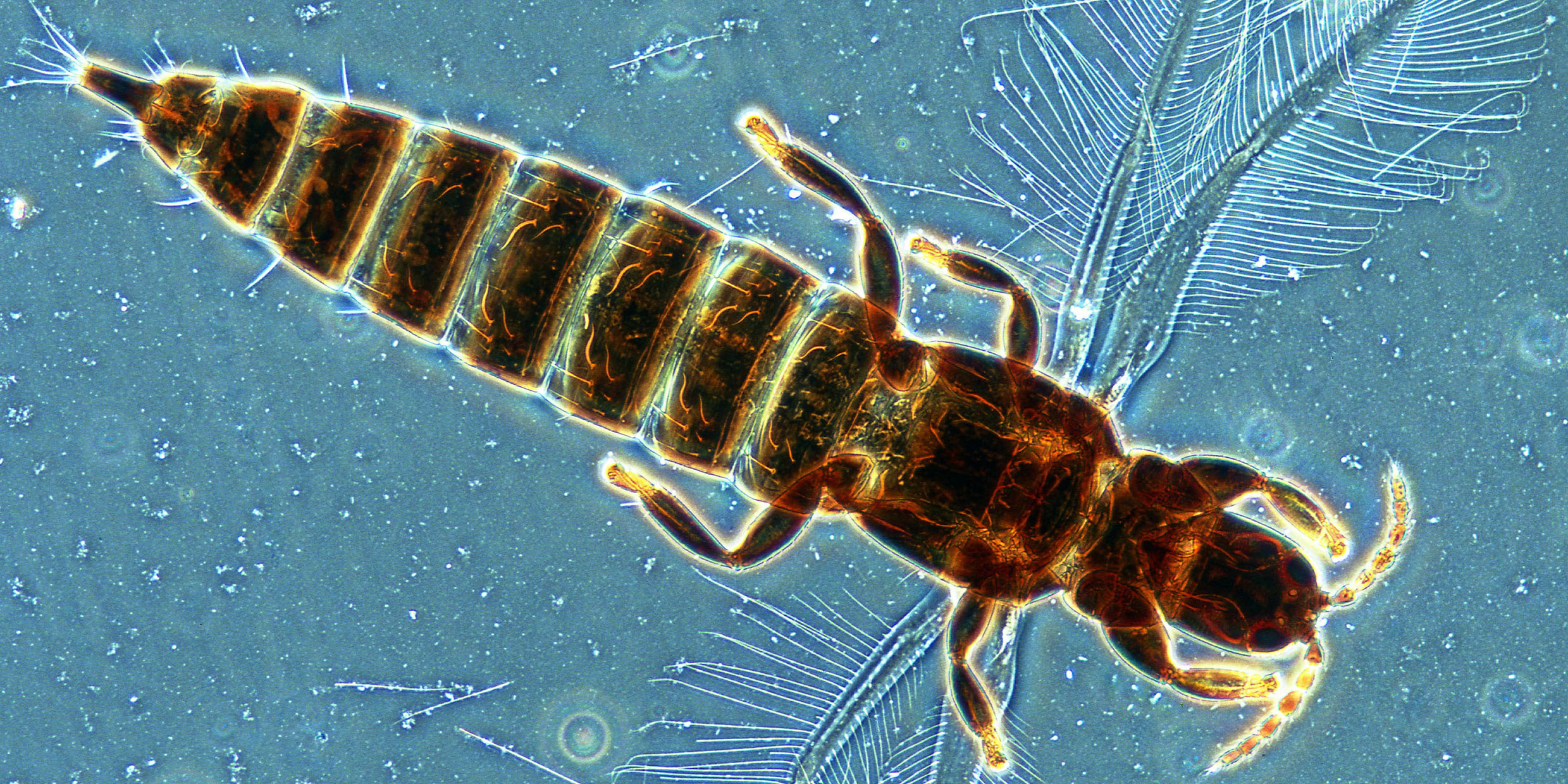Originally published 13 March 1989
According to the news, Vermont maple syrup producers are running scared of the pear “thrip.” This little insect defoliates maple trees, which is not good for the sap.
First, let’s get one thing straight. There’s no such thing as a thrip. The singular of thrips is thrips. The plural of thrips is thrips. As Dr. Seuss might say, “One thrips. Two thrips. Red thrips. Blue thrips.”
But then again, the thrips that afflict maples are neither red nor blue, but blackish or whitish, depending on the stage of their life cycle. Dark adult thrips spend the winter underground, emerging in early spring to feed on buds, blossoms, leaves, and young fruits of various trees, including pears and sugar maples. They deposit eggs in leafstalks. Pale young thrips emerge from eggs, eat, get fat, then fall to the ground, where they take up residence in the soil and lie dormant for the summer. Pupation takes place in late fall, whereupon thrips go back to sleep for the duration of the winter.
A simple life, mostly spent snoozing, by an almost invisibly small insect with a Dr. Seuss sort of name. But in spite of what you now have reason to think, this essay is not about thrips. It’s about humans, about curiosity, and about the Dr. Seuss in all of us. Allow me to go further along my thripsish course before I reveal the moral of the story.
Exploring with a microscope
One of my favorite pastimes — in season — is to plunk a wildflower onto the stage of a dissecting microscope and go exploring. No Darwin in the Galapagos or Humboldt on the Amazon ever surveyed a richer fauna than what exists microscopically on almost any plant. A dandelion can be a tropical forest for the naturalist armed with even a modest degree of optical magnification. Within the stamens and corollas of every meadow weed lurks an astonishing catalog of beasts.
Now I wouldn’t know a pear thrips from a wheat thrips or any other kind of thrips (there are hundreds), but I know a thrips when I see one. Adult thrips have four fringed wings, like tiny oars with eyelashes, and often I’ve seen one skulking about in a flower-head. Magnified 10 times even the wimpishly-named thrips presents a formidable aspect. Eye-to-eye with one of these monsters you begin to understand how a thriving throng of thrips could trash a maple.
No sooner had I read about thrips in Vermont than I came across another thrips story in the journal Nature. “Facultative viviparity in a thrips,” it was called, by Bernard Crespi of the University of Michigan. Crespi has discovered a species of thrips in which females lay eggs (oviparity) or give live birth (viviparity) or both. Oviparous offspring are female, and viviparous offspring are male. During a given bout of reproduction it’s all one way or the other, but long-lived females can change modes and somehow the ratio of sexes balances out. Crespi’s switch-hitting female thrips are apparently the only known animal capable of “choosing” her mode of reproduction in response to subtle signals from within or without.
Little puzzles like this are the delight of evolutionists. How and why did such bizarre behavior evolve? What is the adaptive value of being able to switch reproductive modes? Why is being born live good for males but not for females? Crespi posits plausible explanations, but I wonder if an explanation by natural selection is really necessary. Thrips run the gamut of reproductive strategies. Some lay eggs, some give birth to live young, and one, at least — Crespi’s thrips — has it both ways. Nature seems to have a niche for almost everything. Not even the wildest product of Dr. Seuss’ imagination — the Moth-Watching Sneth, for example, or the Grickily Gractus (that lays eggs on a cactus) — is stranger than creatures that actually exist. The egg-laying/live-birthing Flip-Flop Thrips is a case in point. So is the Syrup-Sipping Thrips of Vermont.
And now I’m warming to my subject. The naturalist Donald Culross Peattie wrote: “The world, from a weevily point of view, seems to exist for the weevils.” He might as well have said that sugar maples, from the pear thrips’ point of view, exist for pear thrips. And, of course, he’s right: it’s all a matter of point of view. I’ll draw my moral like this: From the human point of view, thrips exist for humans.
Following curiousity
Why does a biologist like Crespi spend all that time with nylon-mesh bags filled with dead oak leaves and live thrips, counting offspring, sexing baby thrips, and determining reproductive mode? OK, some thrips are agricultural pests, and one can argue — especially when applying for research grants — that studying the reproductive behaviors of thrips might have an economic payoff. But I doubt if such practical concerns have much to do with Crespi’s motivation, or that of any other entomologist. He’s doing in a serious, scientific way what I do more casually with my microscope — following his curiosity into the bizarre Dr. Seussian world of biological diversity.
There are more than 10 million species of life on this planet, and we are the only one insatiably curious about all the rest. If somewhere there’s a bird that watches moths or lays eggs on a cactus, we want to know about it. Not even the lowliest insect escapes our interest. Why else did I write this thripsy essay? Why else did you read it?



